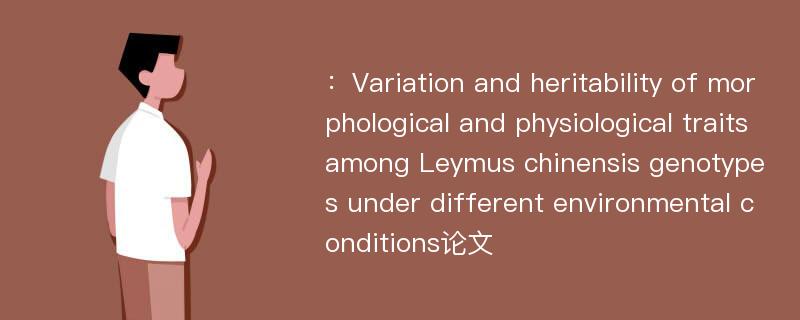
本文主要研究内容
作者(2019)在《Variation and heritability of morphological and physiological traits among Leymus chinensis genotypes under different environmental conditions》一文中研究指出:Intraspecific trait variation and heritability in different environmental conditions not only suggest a potential for an evolutionary response but also have important ecological consequences at the population, community, and ecosystem levels. However, the contribution of quantitative trait variation within a grassland species to evolutionary responses or ecological consequences is seldom documented. Leymus chinensis is an important dominant species in semi-arid grasslands of China, which has seriously suffered from drought and high temperature stresses in recent decades. In the present study, we measured variation and heritability of 10 quantitative traits, namely the number of tillers, maximum shoot height, number of rhizomes, maximum rhizome length, rhizome mass, aboveground mass, root mass, maximum net photosynthetic rate(Pmax), specific leaf area(SLA), and leaf length to leaf width ratio(LL/LW), for 10 genotypes of L. chinensis under one non-stress(Ck) condition and three environmental stress conditions(i.e., drought(Dr), high temperature(Ht), and both drought and high temperature(DrHt)). Result indicated that(1) the interaction of genotype and environmental condition(G×E) was significant for 6 traits but not significant for the other 4 traits as shown by two-way analysis of variance(ANOVA), suggesting that different selection forces were placed for different traits on the factors dominating phenotypic responses to different environmental conditions. Moreover, these significant G×E effects on traits indicated significantly different phenotypic adaptive responses among L. chinensis genotypes to different environmental conditions. Additionally, individuals could be grouped according to environmental condition rather than genotype as shown by canonical discriminant analysis, indicating that environmental condition played a more important role in affecting phenotypic variation than genotype;(2) by one-way ANOVA, significant differences among L. chinensis genotypes were found in all 10 traits under Ck and Dr conditions, in 8 traits under Dr Ht condition and only in 4 traits under Ht condition; and(3) all 10 traits showed relatively low or non-measurable broad-sense heritability(H2) under stress conditions. However, the lowest H2 value for most traits did not occur under DrHt condition, which supported the hypothesis of ’unfavorable conditions have unpredictable effects’ rather than ’unfavorable conditions decrease heritability’. Results from our experiment might aid to improve predictions on the potential impacts of climate changes on L. chinensis and eventually species conservation and ecosystem restoration.
Abstract
Intraspecific trait variation and heritability in different environmental conditions not only suggest a potential for an evolutionary response but also have important ecological consequences at the population, community, and ecosystem levels. However, the contribution of quantitative trait variation within a grassland species to evolutionary responses or ecological consequences is seldom documented. Leymus chinensis is an important dominant species in semi-arid grasslands of China, which has seriously suffered from drought and high temperature stresses in recent decades. In the present study, we measured variation and heritability of 10 quantitative traits, namely the number of tillers, maximum shoot height, number of rhizomes, maximum rhizome length, rhizome mass, aboveground mass, root mass, maximum net photosynthetic rate(Pmax), specific leaf area(SLA), and leaf length to leaf width ratio(LL/LW), for 10 genotypes of L. chinensis under one non-stress(Ck) condition and three environmental stress conditions(i.e., drought(Dr), high temperature(Ht), and both drought and high temperature(DrHt)). Result indicated that(1) the interaction of genotype and environmental condition(G×E) was significant for 6 traits but not significant for the other 4 traits as shown by two-way analysis of variance(ANOVA), suggesting that different selection forces were placed for different traits on the factors dominating phenotypic responses to different environmental conditions. Moreover, these significant G×E effects on traits indicated significantly different phenotypic adaptive responses among L. chinensis genotypes to different environmental conditions. Additionally, individuals could be grouped according to environmental condition rather than genotype as shown by canonical discriminant analysis, indicating that environmental condition played a more important role in affecting phenotypic variation than genotype;(2) by one-way ANOVA, significant differences among L. chinensis genotypes were found in all 10 traits under Ck and Dr conditions, in 8 traits under Dr Ht condition and only in 4 traits under Ht condition; and(3) all 10 traits showed relatively low or non-measurable broad-sense heritability(H2) under stress conditions. However, the lowest H2 value for most traits did not occur under DrHt condition, which supported the hypothesis of ’unfavorable conditions have unpredictable effects’ rather than ’unfavorable conditions decrease heritability’. Results from our experiment might aid to improve predictions on the potential impacts of climate changes on L. chinensis and eventually species conservation and ecosystem restoration.
论文参考文献
论文详细介绍
论文作者分别是来自Journal of Arid Land的,发表于刊物Journal of Arid Land2019年01期论文,是一篇关于,Journal of Arid Land2019年01期论文的文章。本文可供学术参考使用,各位学者可以免费参考阅读下载,文章观点不代表本站观点,资料来自Journal of Arid Land2019年01期论文网站,若本站收录的文献无意侵犯了您的著作版权,请联系我们删除。
